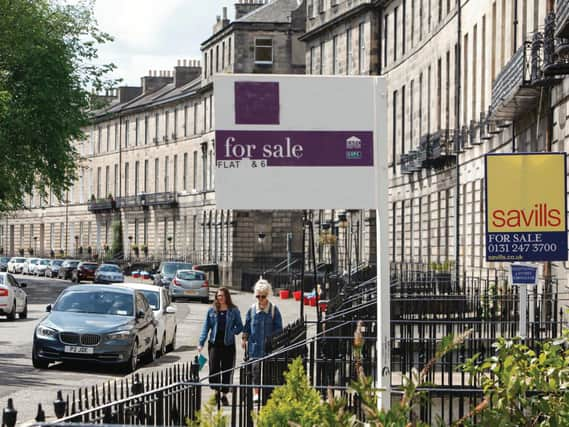Property: Housing market to defy uncertainty


Savills has upgraded its 2021 UK house price forecasts from zero to 4 per cent growth. In addition, the global real estate services provider’s new five-year forecast anticipates total house price growth of 21.1 per cent by the end of 2025 for the UK, with a higher figure of 22.8 per cent for Scotland
The upgraded forecasts follow an unexpectedly strong market in 2020, which saw prices rise by 6.4 per cent during Q4 2020, compared to the same period for the UK and 3.2 per cent in Scotland. This is the first time in modern history that house prices have risen in a recession, as people’s desire to move outweighed the uncertainty surrounding jobs and finances.
Advertisement
Hide AdAdvertisement
Hide AdFaisal Choudhry, Savills’ head of residential research in Scotland, says: “2021 is going to be a complex and uneven year, with competing forces impacting the housing market at different points.
“The outlook has improved since the beginning of the year, given the speed of the vaccination programme, the expected relaxation of social distancing measures on both sides of the Border and government support for jobs and for the housing market.
“New data reveals sales agreed remain well above the pre-pandemic norm, with the same true of mortgage approvals. That points to a strong first half-year which, together with the introduction of the mortgage guarantee scheme, underpins our expectation of 1.4 million transactions in 2021.”
Savills predicts a particularly strong market performance in Scotland, where lower house price to household income ratios leave more capacity for price growth. And the country will continue to attract local upsizers and buyers relocating across the Border.
However, price growth will continue to be moderated by buyers’ spending power over the next one to two years. Once an economic recovery takes hold the government may try to recoup some of the pandemic support costs through taxation. And the longer-term implications of Brexit may also impact consumer spending.
The Scottish residential market has thrived during the pandemic, as it has in England and Wales. Its performance was initially driven by the release of a pent-up demand from buyers who had been waiting in the wings during the first lockdown.
Extended periods of time spent at home appeared to cause potential buyers to reassess how and where they want to live, resulting in a renewed appetite for space and a greater commitment to moving in the short to medium term.
Consequently, the number of agreed sales in Scotland in the last six months of 2020 was 36 per cent higher than the same period in 2019.
Advertisement
Hide AdAdvertisement
Hide AdThis activity is now beginning to feed into official data, with Registers of Scotland reporting the number of sales between October and December last year being 28 per cent higher than during the same months in 2019.
Despite the ongoing lockdown and adverse weather conditions at the beginning of the year, market momentum continued, with January’s transaction levels 12 per cent higher than the same month in 2020.
Analysis of Savills’ data gives cause for future optimism; the number of buyers who registered to buy property in Scotland rose in the first two months of the year, compared to the same period in 2019, and the firm reports a 54 per cent increase in agreed house sales.
Buyers’ desire for more space has triggered a revival in Scotland’s country locations, particularly from town and city dwellers. The number of buyers from Scottish cities purchasing Savills properties in surrounding areas during 2020 was more than double the number recorded in 2019.
Areas that outperformed last year include Aberdeenshire, Dumfries and Galloway, Perthshire, Ayrshire and Stirlingshire.
The markets in Scotland’s cities and commuter areas also remained attractive to buyers on both sides of the Border, due to their relatively green credentials, access to open spaces, resilient local economies and value for money compared to south of the Border.
Sales agreed in such locations during the second half of last year were a third higher than the same period in 2019. Areas that outperformed included Aberdeen City, Dundee City, Renfrewshire and West Lothian.
Despite the surge in sales, price growth has remained relatively modest with an annual rise in average transaction price in Scotland from £180,874 in 2019 to £188,872 last year.
Advertisement
Hide AdAdvertisement
Hide AdLooking to the year ahead, Savills predicts that the impact of the pandemic on the economy is likely to be more keenly felt UK-wide, and the firm expects price sensitivity to remain a feature of 2021.
However, historically low interest rates and the continuing urge for people to relocate to more rural surrounds will continue to drive demand, and consumer confidence is likely to be further boosted as the rollout of Covid-19 vaccines progresses.
Choudhry says: “It will be interesting to see what the legacy of the work from home experiment will be, and if the recent renewed appreciation of greener locations will remain a feature of the market.
“We expect supply constraints to lift prices in particularly desirable hotspots, with good quality and appropriately priced properties continuing to receive competitive bids.”
A message from the Editor:
Thank you for reading this article. We're more reliant on your support than ever as the shift in consumer habits brought about by Coronavirus impacts our advertisers.
If you haven't already, please consider supporting our trusted, fact-checked journalism by taking out a digital subscription.
Comments
Want to join the conversation? Please or to comment on this article.